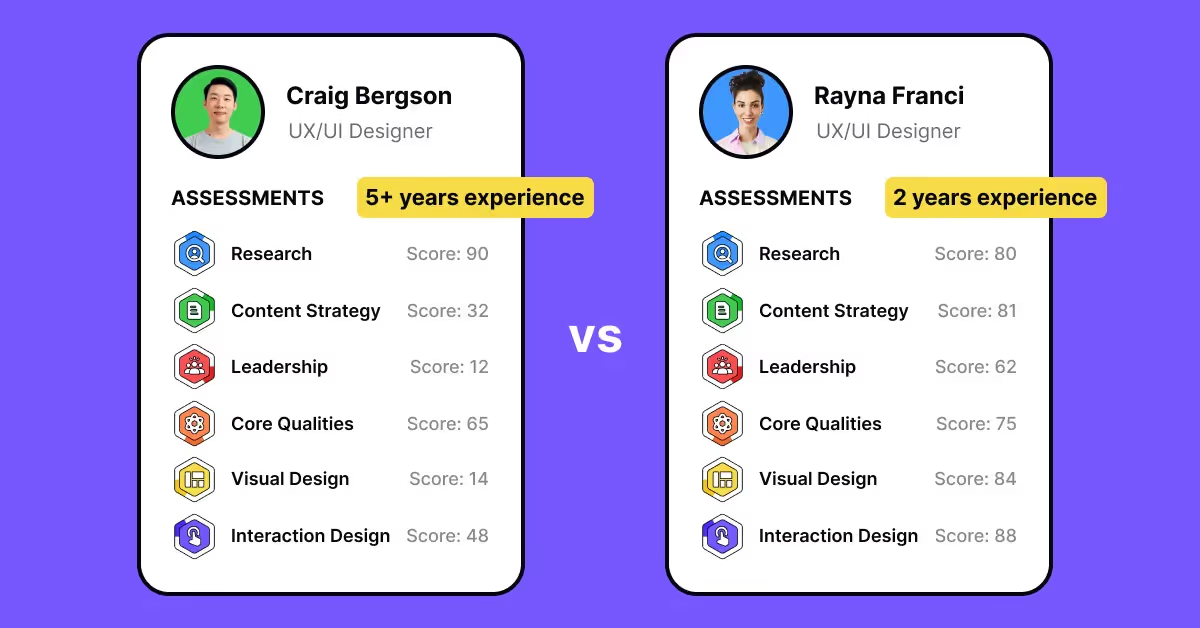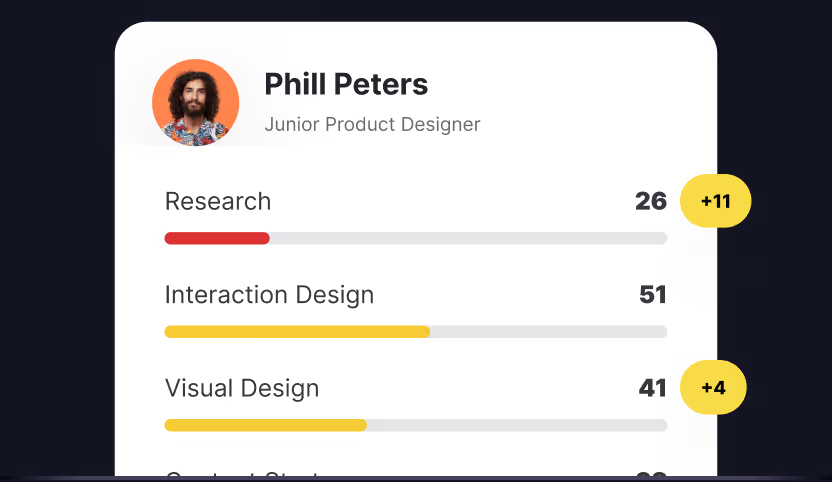
Since UX design is so crucial for a product, many companies decide to find a relevant specialist. Unfortunately, hiring UX designers is a tiresome process that may take weeks before finding the best fit. Hiring managers and UX management are often faced with hundreds of job applications and have only a few seconds to review each one.
In this short time, they must decide which job candidates are worth moving forward with and which ones should be rejected without even considering their resumes. To improve your company's hiring process, reconsider the entire process of finding, screening, and hiring employees.
Problems with the UX Hiring Process
When reviewing resumes, many hiring managers look for the following:
- Work experience with well-known brands
- Extensive experience
- Relevant skills
On the one hand, these criteria make sense. However, as you dig deeper into the design hiring process, you may find that you've overlooked several highly qualified UX designers and given more weight to candidates who may not measure up.
Experience is More Than Just Years on the Job
When looking over a job application, you might overlook a UX designer with some experience at a small agency in favor of one who's worked for three or more years at a company like Google or Microsoft. In reality, experience doesn't always reflect a candidate's skill set and potential.

There's a possibility that a person with a prior experience at the small agency delivered dozens of products for dozens of clients and had more responsibilities. In contrast, designers who have worked for large brands may have been involved in only one or two projects with a limited scope of duties.
It's not uncommon for hiring managers to overlook a candidate with little experience but superior design skills. You might end up hiring a person who has been in the design field for years only to find out that their actual skills don't meet your standards.
Years of experience may matter for some occupations, but UX designer careers rarely follow a linear path. While some designers constantly strive to improve their skills, others coast through their careers without much effort, staying in their comfort zone. The point is that years of experience cannot accurately represent skills and knowledge.
It is easy to be swayed by extensive job experience and the reputation of famous companies listed on a resume. Instead, introduce accurate design skills assessments into the hiring process to really get to know a candidate's abilities. The more you know about a designer's skill set and knowledge of UX design, the better choice you will make.
A college degree isn't a magic pill
Nowadays, a college degree isn't the only way to gain a quality education, build expertise, and master your skills in various design disciplines. Many independent platforms provide a more affordable yet professional approach to learning and getting real-world experience. When reviewing resumes, pay attention to alternative education channels like courses, certified programs, workshops, and boot camps. While traditional education is still an important factor, the lack of a degree in a relevant field on a resume shouldn't be a deal-breaker.
It’s Tough to Assess Design Skills
The first problem with proper skill assessment is that companies often don't know what design skills they are looking for. A second problem is that there's usually no qualified person on a team to assess UX designers for hire or other design specialists professionally.
Let's say you defined your design needs and know what skills you would like a candidate to possess. What tools do you have to assess design skills?
- Resumes
- UX portfolios
- Interviews
- Pre-screening calls
- Design challenges and whiteboard design exercises
The hiring process takes a lot of time and resources, especially if you don't have qualified recruiters on your team and have to handle it on your own.

Reviewing Portfolios is Time-Consuming
A portfolio review alone can be incredibly time-consuming and often gives you little information about a designer's skills. Just because a designer can create an aesthetically pleasing layout doesn't mean they know how to solve real-world design problems. When reviewing a UX portfolio, check if:
- It contains a few case studies describing UX problems
- Each case study is supported with user research findings and user insights
- Each case study describes stages of the design process like ideation, research, analysis, validation, and design
- Each design work shows if the problem was solved and what designers learned from it
When your goal is to hire one designer to speed up the design process, you might have more time at your disposal. However, if you want to scale up a UX design team, you need a more solid plan to improve the hiring process for UX designers.
Design Skills Assessments Are Costly
The hiring process can be speeded up if you select only the most qualified candidates for an interview. Skill assessments can help you narrow down the candidate pool to interview only the designers with the skills your team needs.
Design skills assessments can be costly, though. Besides, many of them don't fully represent designer skills and focus on theory or design software knowledge only. On the flip side, UI/UX design skills assessments help you determine candidates' skill sets before hiring someone who's not the right fit for your team. You can also use the assessments to understand your team’s strengths and growth areas.
How to Improve the Hiring Process for Experienced Designers
1. Post Your Ads on the Right Kind of Job Boards
Look for job boards for UX designers and other design specialists that regularly update job openings, allow you to raise your job description in the list, and are popular with designers.
2. Improve your job descriptions
Hiring is a two-way process that involves your company and the candidates. Candidates make the first move and decide whether to apply for your job or keep scrolling. Your goal is to attract the right person with your job description. Besides, upfront clarity on the role prevents miscommunication and excessive applications.
Make sure the job description includes:
- Your business mission, goals, and company culture
- Role responsibilities and job requirements
- The benefits of taking the job
- Other relevant information (e.g., whether it's a remote, on-site, or hybrid position)
For example, when hiring a UX designer, you're likely to expect them to:
- Have a solid knowledge of user experience and UX design
- Provide a UX portfolio
- Be familiar with usability testing, user interviews, card sorting, thematic analysis, and research methods
- Have the knowledge to create user flows, wireframes, and prototypes
- Understand the key concepts of color psychology, typography, and composition
- Have excellent problem-solving, communication, critical thinking, and analytical skills
3. Adopt A One-Time Pre-Screening Call Per Candidate
Pre-screening phone interviews usually take 10-30 minutes and help companies to eliminate candidates that don't meet the basic requirements.
What does an average pre-screening call include?
- Confirmation of the applications
- A short overview of a company and position to filter out job seekers who disagree with company policy or position requirements
- Evaluation of a candidate's resume and salary expectations
- Questions from candidates
- Other clarifications of any doubts that may block the hiring process
4. Break down the interview process
Split the entire interview process into technical and non-technical parts and, if necessary, break it down into two days. Interviews that take more than two hours can be too exhausting for both sides.
During the technical interview, your goal is to assess whether a candidate possesses enough expertise to perform the duties required by the role. You can ask them technical questions or offer them a short design challenge to see how they solve problems in practice.
Non-technical interviews are focused on assessing a designer's soft skills. A hiring manager should pay attention to a candidate's abilities to:
- Communicate with other designers, UX researchers, and developers
- Provide constructive feedback
- Articulate their design decisions to a team
- Describe their design process
- During the second interview, ensure your questions are aimed at finding out how designers behave in specific situations. You may ask them about their most challenging projects or times when they failed, succeeded, or disagreed with a client.
5. Follow diversity, equity, and inclusion standards
Improve the hiring process by removing any biases and providing a welcoming environment for all candidates. Hiring managers should avoid asking questions that attempt to reveal birth date, gender, class, ethnicity, disability, sexual orientation, or other factors that may prevent skilled candidates from being hired.
Where Uxcel fits into the hiring process
There is no doubt that every company wants to hire the "best of the best," but how many actually know what that means? What are the criteria for selecting the most talented designers? How can you measure whether those parameters are met?

With Uxcel's smart assessment tools, companies can get an objective evaluation of a designer's skills and identify candidates with the right set of skills based on relevant design criteria.
Once you find a candidate who seems to be a perfect fit for a specific role and you consider inviting them to an interview, ask them to take a skills assessment first. Then, you can compare candidates' results to those of Uxcel's 140,000 users or to your own design team.
Are there specific questions you would like to ask to verify the technical or soft skills of applicants? Uxcel allows you to customize assessments and learn exactly what you need to know about your candidates. Our recruit tool for companies aims to help them fill the desired design roles with minimal time and effort.




